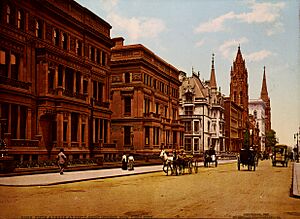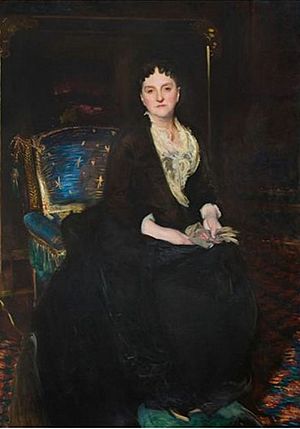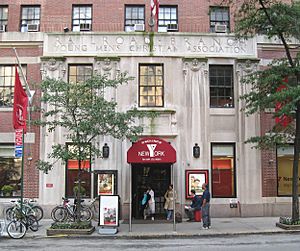William Henry Vanderbilt facts for kids
Quick facts for kids
William Henry Vanderbilt
|
|
|---|---|
 |
|
| Born | May 8, 1821 |
| Died | December 8, 1885 (aged 64) Manhattan, New York City, New York, U.S.
|
| Resting place | Moravian Cemetery |
| Education | Columbia College (1841) |
| Occupation | Owner of the New York Central Railroad and other railroads. |
| Net worth | |
| Political party | Republican |
| Spouse(s) |
Maria Louisa Kissam
(m. 1841) |
| Children | Cornelius, Margaret, Allen, William, Emily, Florence, Frederick, Eliza, and George |
| Parent(s) | Cornelius Vanderbilt Sophia Johnson |
| Relatives | See Vanderbilt family |
| Signature | |
William Henry Vanderbilt (born May 8, 1821 – died December 8, 1885) was an important American businessman. He was also known for giving money to good causes, which is called philanthropy. William Henry was the oldest son of Cornelius Vanderbilt, a very rich and powerful man. William Henry inherited his father's huge fortune and became a leading member of the famous Vanderbilt family.
After his father passed away in 1877, William Henry became the richest person in America. He kept this title until he died in 1885. He made sure to pass on a large part of his wealth to his wife and children, especially his sons Cornelius II and William. He inherited about $100 million from his father. In less than nine years, he managed to double that fortune!
Contents
Early Life and Family
William Henry, often called "Billy," was born in New Brunswick, New Jersey, on May 8, 1821. His parents were Cornelius Vanderbilt and Sophia Johnson.
His father, Cornelius, was quite strict with him. However, their relationship changed a lot during a family trip to Europe in 1860. After this trip, they became much closer. Billy then started to play a bigger role in the family's businesses.
Billy attended Columbia College in 1841. However, he did not finish his degree there.
Building a Business Empire
William Henry's father carefully taught him about business. He started working at age 19 as a clerk in a New York bank. Later, he joined the Staten Island Railway as an executive. In 1862, he became its president. Three years later, he was made vice-president of the Hudson River railway.
In 1869, he became vice-president of the New York Central and Hudson River Railroad. By 1877, he was its president. When his father died, William Henry took over as president of several other major railroads. These included the Lake Shore and Michigan Southern Railway, the Canada Southern Railway, and the Michigan Central Railroad.
William Henry Vanderbilt's railroad businesses were very large. They included many important lines across the country.
A Famous Quote: "The Public Be Damned!"
In 1883, a reporter asked William Henry about his express trains. The reporter wondered if these trains made money or if they were for the public's convenience. Vanderbilt's answer became very famous. He said, "Accommodation of the public? The public be damned! We run them because we have to."
This quote caused a lot of bad publicity for him. He later explained that he meant railroads are run to make money, not just for public benefit. He said, "Railroads are not run for the public benefit, but to pay."
Helping Ulysses S. Grant
In 1884, a company called Grant & Ward went bankrupt. This caused big financial problems for many people, including former President Ulysses S. Grant and William Henry Vanderbilt. Grant had convinced Vanderbilt to invest $150,000.
One of the company's partners, Ferdinand Ward, was running a dishonest scheme. He was later punished for it. To pay Vanderbilt back, Grant had to use his valuable Civil War items as collateral, including his sword. Even though this did not cover the full amount, Vanderbilt accepted the items. He then cleared Grant's debt. After Grant died in 1885, Vanderbilt made sure to return all of Grant's war memorabilia to his wife, Julia Grant.
Family Life and Legacy
In 1841, Billy married Maria Louisa Kissam (1821–1896). They had nine children together:
- Cornelius Vanderbilt II (1843–1899)
- Margaret Louisa Vanderbilt (1845–1924)
- Allen William Vanderbilt (1846–1847)
- William Kissam Vanderbilt (1849–1920)
- Emily Thorn Vanderbilt (1852–1946)
- Florence Adele Vanderbilt (1854–1952)
- Frederick William Vanderbilt (1856–1938)
- Eliza Osgood Vanderbilt (1860–1936)
- George Washington Vanderbilt II (1862–1914)
In 1883, William Henry stepped down from leading his companies. He appointed his sons to important roles. However, he left the daily running of the businesses to experienced managers.
He passed away on December 8, 1885, in New York City. He was buried in the Vanderbilt family mausoleum at the Moravian Cemetery on Staten Island. His wealth was divided among his eight children and his wife. Most of it went to his two oldest sons, Cornelius and William.
Giving Back: Philanthropy
William Henry Vanderbilt was a very generous person. He gave a lot of money to many good causes. He supported the YMCA and helped to create the Metropolitan Opera. He also gave money to the Columbia University College of Physicians and Surgeons.
In 1880, he provided funds for Vanderbilt University in Nashville, Tennessee. This money helped build the Wesley Hall building. It was used for the Biblical Department, a library, dorm rooms, lecture halls, and a cafeteria. When the building was destroyed by fire in 1932, his son Frederick made another donation to help rebuild it.
Vanderbilt loved art. He collected more than 200 valuable paintings by famous artists. He kept these beautiful artworks in his grand mansion on Fifth Avenue.
Images for kids
-
The Vanderbilt family mausoleum at the Moravian Cemetery on Staten Island, where William Henry is buried.
See also
 In Spanish: William Henry Vanderbilt para niños
In Spanish: William Henry Vanderbilt para niños
- List of richest Americans in history






